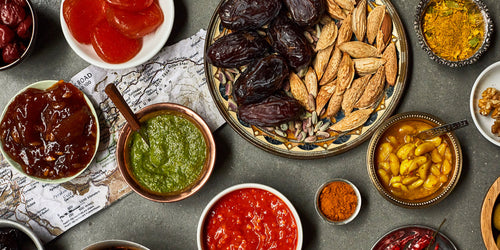Your Cart is Empty
Gochujang is essential in Korean meals. In fact, it’s one of the mother sauces of the cuisine. It’s the base of many stews and soups, used in banchan and condiments and is one of the main components of ssamjang, the most common sauce served with Korean barbecue. Gochujang is spicy, but it’s not like your regular bottle of Tabasco or Sriracha, so what makes it special?
What is Gochujang?
Along with the fermented soybeans, gochujang is made with glutinous rice, malt, salt and red chile pepper flakes called gochugaru. It was traditionally made at home and left to ferment for months in the pre-summer sun in an earthenware pot outdoors. Over time, the starch in the glutinous rice turns to sugar and lends gochujang its characteristic sweetness. The fermented soybeans give the paste umami, which is why many quick gochujang substitute recipes rely on miso for a slightly funky flavor. And the pepper flakes, of course, give gochujang its signature vibrant color and heat, though the spiciness level can vary widely in different versions of gochujang. Gochujang is naturally gluten free, but some products include wheat or barley to thicken the paste so, if you can’t eat gluten, it’s important to double check the label before buying.

What’s the Best Gochujang?
East coast based brand RHEI-MAID uses meticulously sourced ingredients and a slow, unexpedited fermentation process to create an intense, luscious gochujang.

Rhei-Maid President Mary Rhei says, “We continue to employ the same artisanal craft used for well over 200 years. We are naturally gluten free, non-gmo and without preservatives, which is why we must be refrigerated at all times. Our true authentic homemade taste is ‘Just like Halmoni's (Grandma's) because it is still her recipe.’”
Mother in Law’s Gochujang Concentrate is a super thick version of the fermented paste with a moderate heat level. It blends well in marinades and makes an addictive spicy mayo. Because it’s a concentrate, it tastes best if you mix it into something with liquid so it gets diluted. The company was started in California by Lauryn Chun in 2009 to sell kimchi and expanded to gochujang in 2014. The artisan brand does not use any MSG or corn syrup and was the first brand of its kind to be sold in specialty stores. Mother in Law’s also makes a Garlic Gochujang Sauce, perfect as a gochujang marinade in and of itself, and a Sesame Gochujang Sauce that includes sesame oil and roasted peanuts and makes a great gochujang dipping sauce for bibimbap or ramen. These two products add extra ingredients to thin out the concentrated paste and turn it into a true condiment or marinade.

O’Food Gochujang is a classic version of the chile paste that comes in the recognizable plastic red 18 ounce tub. 18 ounces may seem like a lot, but because the paste is fermented only good bacteria can thrive in it and it will last a long time in your refrigerator. This version is made with brown rice and has a relatively mild spice level.
Another traditional product is this Kisoondo Garlic Gochujang. It’s made with a family recipe that has been passed down for ten generations. Garlic, which has long been used in Korean food to improve the taste of older meat, is added before the fermentation begins so all of the flavors are harmoniously incorporated at the end of the six month aging process.
For a cross-over condiment that has TWO sources of heat, try Weak Knees Gochujang Sriracha. It brings the heat of Sriracha and the complexity of Gochujang, making this a quintessentially Brooklyn condiment and a key ingredient in our ultimate breakfast sandwich and so much more.
How to Use Gochujang

Ready to get started on your Korean home cooking adventure? The Snuk Korean Gift Box includes gochujang, doenjang, ganjang, gochugaru, Korean barbecue rub, short grain rice and chef Judy Joo’s brilliant introductory bookKorean Food Made Simple, which (no surprise) has many recipes that use gochujang. You don’t have to limit yourself to only using gochujang in Korean food though. Joo has an indulgent recipe for spicy mussels with bacon on her website that results in an intensely delicious broth to ladle over rice. Mary Rhei also says, “In a non-traditional way, gochujang gives an added burst of umami and spice to any food, such as ketchup, bbq sauce, mayo and even Bloody Marys.”
For More Gochujang Recipes Click Here




